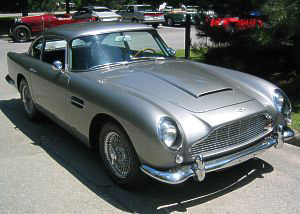The Aston Martin DB5 is a luxury grand tourer that was made
by Aston Martin and designed by the Italian coachbuilder Touring Superleggera.
Released in 1963, it was an evolution of the final series of DB4. The DB series
was named honouring David Brown (the head of Aston Martin from 1947–1972). The
DB5 is famous for being the first and most recognised cinematic James Bond car,
first appearing in Goldfinger (1964).
 |
| Aston Martin DB5 (1964) |
The principal differences between the DB4 Series V and the
DB5 are: The all-aluminium engine was enlarged from 3.7 L to 4.0 L, A new
robust ZF five-speed transmission (except for some of the very first DB5s) and three SU carburettors Producing 282 bhp (210 kW), which propelled the car
to 145 mph (233 km/h), this engine, available on the Vantage (high powered)
version of the DB4 since March 1962, became the standard Aston Martin power
unit with the launch in September 1963 of the DB5.
Standard equipment on the DB5 included reclining seats, wool
pile carpets, electric windows, twin fuel tanks, chrome wire wheels, oil cooler,
magnesium-alloy body built to superleggera patent technique, full leather trim
in the cabin and even a fire extinguisher. All models have two doors and are of
a 2+2 configuration. A three-speed Borg-Warner DG automatic transmission was
available as well. At the beginning, the original four-speed manual (with
optional overdrive) was standard fitment, but it was soon dropped in favour of
the ZF five-speed. The automatic option was then changed to the Borg-Warner
Model 8 shortly before the DB6 replaced the DB5.
 |
| Aston Martin DB5 (1964) |
DB5 Vantage
The high-performance DB5 Vantage was introduced in 1964
featuring three Weber twin-choke 45DCOE side-draft carburettors and revised
camshaft profiles, delivering greater top-end performance at the expense of
overall flexibility, especially as legendary Webers are renowned as
'full-throttle' devices. This engine produced 315 hp (235 kW). Only 65 DB5
Vantage coupés were built.
DB5 convertible
Just 123 convertible DB5s were produced (also with bodies by
Touring), though they did not use the typical "Volante" name until
1965. The convertible model was offered from 1963 through to 1965. Originally
only 19 of the 123 DB5 Convertibles made were left-hand drive. 12 cars were
originally fitted with a factory Vantage engine, and at least one further
convertible was subsequently factory fitted with a DB6 specification Vantage
engine.
 |
| Aston Martin DB5 (1964) |
From October 1965 to October 1966, Aston Martin used the
last 37 of the Aston Martin DB5 chassis' to make another convertible model.
These 37 cars were known as "Short Chassis" Volantes and were the
first Aston Martins to hold the "Volante" name. Although calling it a
"Short Chassis" is a bit of a misnomer as the "short" comes
from comparing it to the subsequent DB6, which has a longer chassis. When
compared to the DB5, it is not "short" but rather the same size,
however these cars differ to the DB5 convertible models as they feature DB6
split front and rear bumpers and rear TR4 lights, as also used on the DB6.
The Aston Martin DB5 is one of the most famous cars in the
world thanks to Oscar-winning special effects expert (also known as 'the Real
Q') John Stears, who created the deadly silver-birch DB5 for use by James Bond
in Goldfinger (1964). Although Ian Fleming had placed Bond in a DB Mark III in
the novel, the DB5 was the company's latest model when the film was being made.
 |
| Aston Martin DB5 Convertible (1964) |
The car used in the film was the original DB5 prototype,
with another standard car used for stunts. To promote the film, the two DB5's
were showcased at the 1964 New York World's Fair, and it was dubbed "the
most famous car in the world", and subsequently sales of the car rose. In
January 2006, one of these was auctioned in Arizona; the same car was
originally bought in 1970 from the owner, Sir Anthony Bamford, by a Tennessee
museum owner. A car, mainly used for promoting the movie, is now located in the
Louwman Museum, Netherlands. The first DB5 prototype used in Goldfinger with
the chassis number DP/216/1 was later stripped of its weaponry and gadgetry by
Aston Martin and then resold. It was then retrofitted by subsequent owners with
nonoriginal weaponry. The Chassis DP/216/1 DB5 was stolen in 1997 from its last
owner in Florida and is currently still missing.
 |
| Aston Martin DB5 Convertible (1965) |
Within the universe of James Bond, the same car
(registration BMT 216A) was used again in the following film, Thunderball, a
year later. A different Aston Martin DB5 (registration BMT 214A) was used in
the 1995 Bond film, GoldenEye, in which three different DB5s were used for
filming. The BMT 214A also returned in Tomorrow Never Dies (1997) and was set
to make a cameo appearance in the Scotland-set scenes in The World Is Not
Enough (1999), but these were cut in the final edit. Yet another DB5 appeared
in Casino Royale (2006), this one with Bahamian number plates and left-hand
drive (where the previous British versions had been right-hand drive). Another
silver-birch DB5 with the original registration BMT 216A is used in the 23rd
James Bond film, Skyfall (2012).
On 1 June 2010, RM Auctions announced the upcoming auction
of a DB5 used in both Goldfinger and Thunderball. The owner (Jerry Lee,
president/owner of WBEB Radio in Philadelphia, Pennsylvania) originally bought
the car from the Aston Martin company in 1969. At the auction, the DB5 was sold
for 2,600,000 Pounds Sterling.


Niciun comentariu:
Trimiteți un comentariu